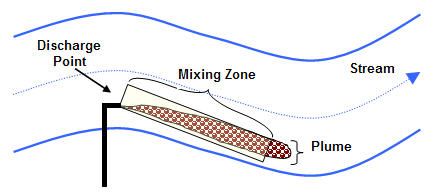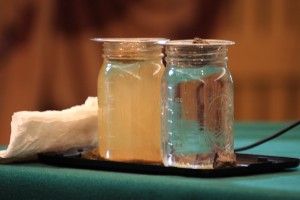DEP Proposed Change to Water Quality Standards Threatens Drinking Water, the Health of Bays & Estuaries and Fish and Aquatic Life
DEP Plan Would Allow Miles Of River to Dilute Pollution Discharges
Tom Johnson at NJ Spotlight has a good story today about a major DEP proposal that would seriously weaken current NJ water quality standards and threaten drinking water supplies and the ecological health of NJ’s major rivers, bays, and estuaries, particularly Raritan Bay and the NY/NJ Harbor complex, see:
Bill Wolfe, New Jersey director of Public Employees for Environmental Responsibility (NJPEER), said the DEP’s proposed new approach fails to consider the ecological impacts of nitrogen on waterways.
“It ignores longstanding historical policy of ‘source water protection’ — that the policy burden on the wastewater dischargers is to protect water supplies — and shifts quite a bit of the cost and compliance burden onto the water purveyors,’’ Wolfe said.
Readers might want to examine the DEP’s “Source Water Protection” policy set under the federal Safe Drinking Water Act.
The primary pollutant addressed by the DEP’s plan is nitrate, although it also would eliminate current numeric standards for total dissolved solids, chloride (salt) and sulfate.
- The Origin of The Current DEP Plan
The origin of the proposal goes way back to the Whitman administration, when sewage treatment plants sought to get relief from a series of costly stricter new pollution control permit limits.
To secure that relief, the polluters advocated a complex series of changes to water quality standards regulations and how those standards are measured and enforced in pollution discharge permits.
This is complex, but basically, water quality standards must be set to protect the designated use of a waterbody, i.e. fishing, swimming, drinking water, recreation. In turn, pollution discharge permits must be shown to meet water quality standards. There are two ways to monitor and measure compliance with the water quality standard: 1) at the end of the discharge pipe; or 2) somewhere in the river or stream, typically after considering what is known as a “mixing zone” where pollution is allowed to dilute.
The key concept the polluters relied on was to allow more dilution of pollution, by seeking to expand what are called “mixing zones”, instead of measuring compliance with water quality standards at “end of the discharge pipe”. This illustration shows that concept:
That dilution approach contradict fundamental policy on what was called pollution prevention and source water protection. The gist of both of those policies is that it is better – environmentally and economically – to avoid pollution in the first place than to clean it up. Since the 1990’s, those basic concepts and policies have since been forgotten or ignored or gutted.
At the time (circa 1997) environmentalists, myself included, were able to derail those efforts when, during a DEP “Stakeholder process”, we were able to obtain a memorandum from the DEP Assistant Commissioner for water resources Dennis Hart that stated:
“The proposed changes would increase the amount of carcinogens discharged to public water supplies”
I still recall reaction to that quote when we held a press conference blasting the DEP plan and it hit the newspaper. Governor Whitman herself had to deny that DEP would ever do that. Case closed. We blew that up and it hasn’t re-emeged since.
Until now, when polluters again have the receptive ear of a Governor and DEP Management Cabal that want to rollback environmental protections and provide “regulatory relief”.
- The Problems Caused By Nitrate
NJ rivers receive billions of gallons of pollution discharges from hundreds of sewage treatment plants. Those plants do not have permit limits to control the discharge of total nitrogen. Nitrogen comes primarily from human wastes and, without going into the chemistry of wastewater treatment, occurs in several forms: ammonia, nitrite, nitrate, and organic nitrogen.
As a result of the lack of pollution limits on total nitrogen, nitrate levels in NJ’s rivers are way too high and reaching critical levels that threaten both water supply and the ecological health of the river, especially the downriver bays and estuaries that receive the cumulative pollution loadings of multiple sewage treatment plants, in addition to non-point source pollution from storm water runoff.
At the same time, NJ relies on those same rivers that receive all those pollution discharges as sources of water supply.
Water is taken directly from the rivers and treated, or pumped to fill reservoirs. In either case, nitrogen pollution from sewage discharges creates several serious risks to drinking water.
Nitrate causes “blue baby syndrome”, which is potentially fatal in infants. It is also a suspected carcinogen, endocrine disruptor, and can damage the thyroid gland and create a host of negative metabolic, development effects and health problems.
Nitrate aslo has indirect effects by increasing the growth of algae growth in the river water supplies. The algae must be treated and removed. The disinfection and treatment to remove this organic content in the water column increases the formation of tri-halomethanes (THM) – which are carcinogens – in drinking water.
Drinking water systems are facing compliance problems with drinking water standards (MCL’s) for nitrate and THM because our rivers are too polluted.
Nitrogen also causes ecological problems – it is a plant fertilizer and causes huge growth in algae. That leads to critically low dissolved oxygen levels that kill fish and other aquatic life.
- DEP’s Alleged Justification for the Plan
Here is the DEP powerpoint presentation they made a few weeks ago to a “by invitation only” “Stakeholder” group.
Who are these stakeholders?
DEP provides 3 basic reasons for the Plan – they parrot and could have been written by the sewer plant lawyers:
- In NJ, all freshwater is designated as drinking water
- Due to small size, not all streams are appropriate for drinking water intakes
- Numerous permits have been adjudicated [challenged] on this issue, as a result both small and large dischargers have delayed upgrades
Translation: NJ DEP water quality standards are too strict and too costly to meet and we simply won’t upgrade the pollution controls at our plant to meet them and DEP can’t make us do so!
DEP then gets down to the regulatory nitty gritty:
- water quality standards (SWQS) and Drinking Water Act both have nitrate criteria [standards] of 10 mg/L
- criteria is an acute standard and is applied at the edge of the mixing zone
- potable surface water treatment typically is not designed to remove nitrate
Translation: Notice how DEP mentions only drinking water and doesn’t tell you that SWQS fail to consider ecological impacts on eutrophication and low dissolved oxygen dead zone. DEP doesn’t say that Mixing zones are designed to allow dilution and provide relief from strict permit standards. DEP ask doesn’t tell you that sewage plants do not have nitrate limits and are not required to remove nitrogen!
But buried DEP’s second bullet and ignored is the fact that thePlan would essentially allow the entire river to be used as a mixing zone.
This is done by applying the new water quality standard not at the end of the pipe, and not at the edge of the mixing zone as is currently done, but at the water supply intake. In many places, this is miles downriver from the discharge location.
This amounts to a HUGE mixing zone!
Last, DEP doesn’t tell you that because drinking water plants do not remove nitrate, that all the nitrate in the river passes straight through to your tap! This is how DEP masks that:
- potable surface water treatment typically is not designed to remove nitrate
And DEP doesn’t say what the health effects of that lack of treatment are (and its not just nitrate pollution that passes through untreated).
For the health effects of hundreds of other chemicals discharged upstream of our drinking water intakes, see:
Finally, the DEP Plan would let polluters that discharge to small streams and those without water supply intakes completely off the hook – DEP describes this as “relief”.
Multiple small sources have cumulative impacts and in addition to drinking water risks, nitrogen loads have ecological impacts and cause lower dissolved oxygen levels.
This under-protects our fish and aquatic life, particularly oxygen sensitive species like trout.
- DEP Plan Conflicts with DRBC and US EPA Nutrient Standards and Control Strategies
Interestingly, the Delaware River was exempted from the proposal, because it would violate DRBC water quality standards and the downriver States (Pennsylvania and Delaware) members of the Delaware River Basin Commission (DRBC) would never allow DEP to get away with it.
DRBC is taking the exact opposite approach than DEP, and cracking down on nitrogen pollution loads to the river to protect the Delaware estuary. Excessive nitrogen loadings are creating dead zones and low dissolved oxygen levels that kill fish and aquatic life in the River and Bay.
For details of that DRBC effort, hit this link to see that DRBC nutrient management initiative.
Similarly, for nearly two decades, the US EPA has been working on a nutrient TMDL for the NY/NJ Harbor Estuary complex, which will require huge nitrogen load reductions and impose strict new nitrate permit limits on NJ’s sewage treatment plant dischargers to the Passaic, Raritan, Rahway and Hackensack Rivers, and Newark Bay and NY Harbor, hit this link to read an overview.
- What’s Next?
The DEP Plan has not been announced publicly and formally proposed as a regulation yet.
Therefore, it is not locked in stone and there is time to derail it.
To do so, I assume that the water purveyors will weigh in behind the scenes. There also needs to be some public pressure brought to bear on DEP Commissioner Martin and Governor Christie.
Reporters shouldPose the same question that was posed to Gov. WHitman:
Why would DEP allow more pollution to be discharged into public water supplies?
I will contact US EPA, because I have no confidence in DEP managers under the Christie regime.




Pingback: サーチ低価格を見つける
Pingback: 今日では、ラッシュ
Pingback: 60AOFF
Pingback: 大きい割引と世界中へお届けしますオンライン。
Pingback: 65%を保存すウ
Pingback: 60<OFF
Pingback: 私たちのディスカウントショップで
Pingback: 60%オフ
Pingback: 、豪華アイテムを購入するようになりまし余分なクーポンを入手!
Pingback: セール
Pingback: オンラインで購入方法
Pingback: 送料無料&快速対応!
Pingback: 販売オンライン2014
Pingback: アウトレット問い合わせオンライン
Pingback: 公式ストアで
Pingback: 60/OFF
Pingback: ショップ今すぐ!最高のオンライン予約情報を入手
Pingback: 夏の楽しみを浴び
Pingback: 、あなたは自由船積みを楽しむことができます
Pingback: 2つ目の購入時に余分な20%の割引を取得します
Pingback: 60%OFF
Pingback: 顧客サービスと速い配送でお客様に手入れ。
Pingback: 送料無料
Pingback: オンラインショップ
Pingback: 609OFF
Pingback: 高品質で最も安い価格で
Pingback: 、あなたが質の高い心配しないであなたが待っている
Pingback: asics nimbus 13
Pingback: 私たちのクリアランス店で
Pingback: 健康なアペタイトのため貯蓄をだまし取る
Pingback: 貯蓄
Pingback: 私たちの店でのアイテムの最高品質をお楽しみください
Pingback: 親切な顧客サービスと最速の配達
Pingback: アウトレット
Pingback: アウトレットセール
Pingback: 割引80%オフまる
Pingback: 豪華なアイテムストアが安い土産物店で混合
Pingback: アウトレットオンラインショップ
Pingback: クーポンコード
Pingback: 優れた顧客サービスと
Pingback: 適切な選択
Pingback: 65%を保存ず
Pingback: cheap wow gold
Pingback: Cheap Christian Louboutin
Pingback: asics gel nimbus 13 womens
Pingback: asics gel blur
Pingback: wow gold
Pingback: asics gel nimbus 14 womens
Pingback: asics onitsuka tiger
Pingback: asics gel pulse